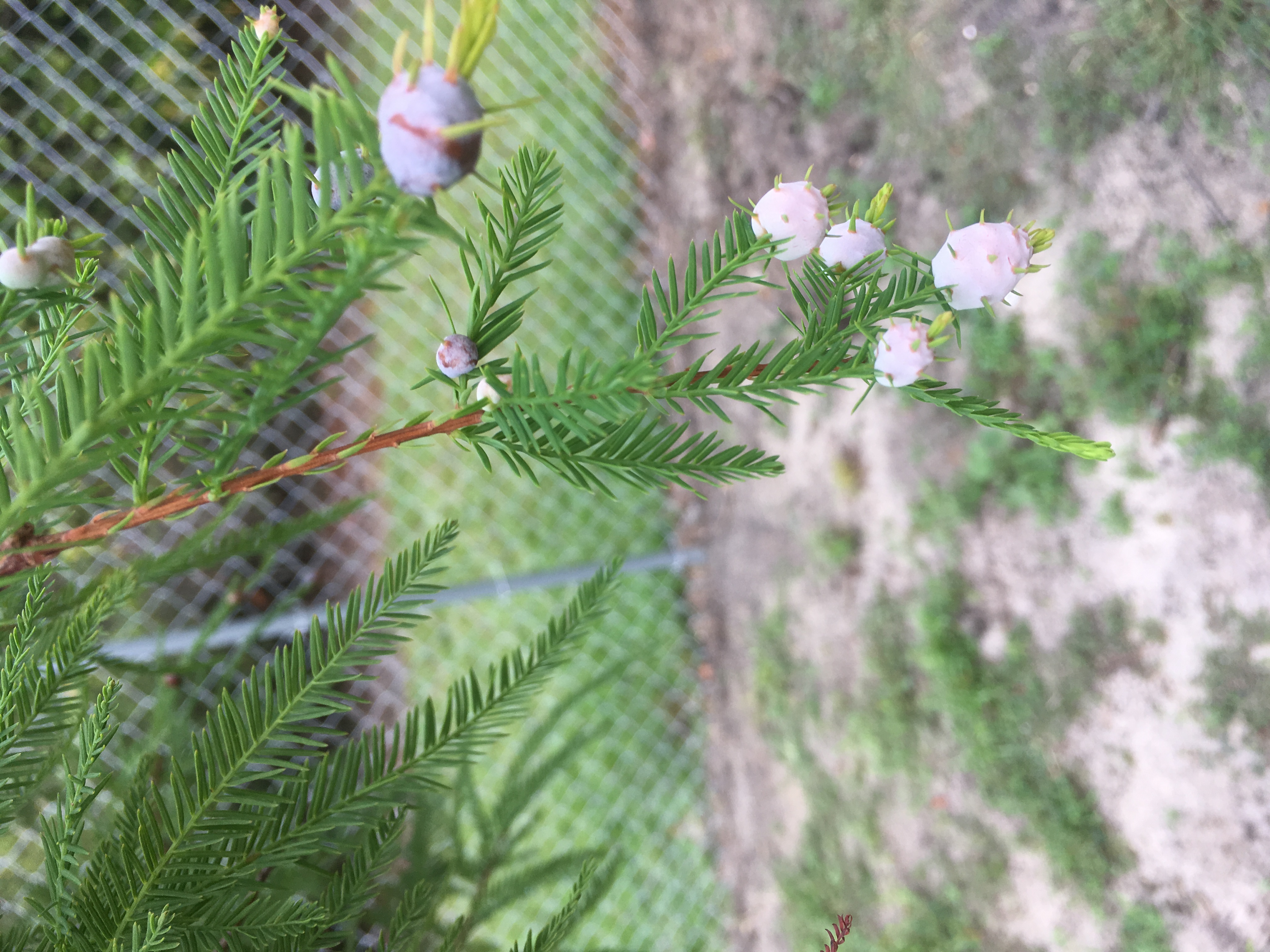
by Julie McConnell | Oct 23, 2017

Cypress twig galls on bald cypress leaves. Photo: J_McConnell, UF/IFAS
Bald cypress Taxodium distichum is a native tree that is commonly planted in landscapes because it is adaptable to many sites and grows quickly. It is an interesting tree because it has soft flat leaves that fall off in the winter like other deciduous shade trees; however, it belongs to the Cypress family which consists mostly of needled evergreens.
Like the other cypresses, bald cypress produces cones in the fall, which is a primary means of reproduction for the species in natural settings. During the same season that cones are maturing, you might also see what looks like cones forming at the tips of branches among the leaflets rather than along the stem. These mysterious growths are not cones but rather twig galls.
Bald cypress twig galls are abnormal growths of leaf bud tissue triggered by the attack of the cypress twig gall midge Taxodiomyia cupressiananassa. In late spring, adult midges lay eggs on new leaves of the bald cypress. As the eggs hatch and midge larvae start feeding on the bald cypress leaves the growth of a twig gall is induced. The larvae take advantage of this gall using it for food and shelter throughout the larval stage and into the pupal stage. After pupation, adults emerge from the galls, mate, and females lay an average of 120 eggs over a two-day lifespan as an adult. This first generation lays eggs on mature leaves which starts the cycle again. The galls formed by the second generation of the year fall off and overwinter on the ground.
The galls do not appear to affect the health of trees overall, although the weight of heavily infested branches may cause drooping. There are many natural enemies of the twig cypress gall midge, so applying insecticides are not recommended since they may cause harm to non-target insects. The simplest management option is to collect and destroy the galls in the spring and fall to reduce populations the following season.
To read more about bald cypress trees or the twig gall please see the following publications:
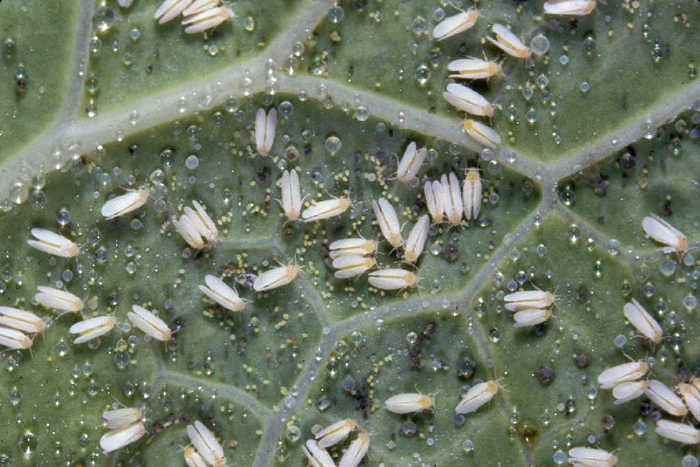
by Matt Lollar | Oct 2, 2017
Over the last month or so, home gardeners and commercial growers alike have noticed what look to be large dust particles floating through the air. It’s probably not uncommon to have inhaled a few or even a few hundred of these mysterious particles. Most likely, these “particles” aren’t dust at all but whiteflies instead. Whiteflies are small (less than a tenth of an inch long), white, soft-bodied insects. They aren’t flies but are considered ‘true bugs’ by entomologists. The most common whitefly species in Northwest Florida is the silverleaf whitefly, also known as the sweetpotato whitefly. Whitefly numbers have exploded exponentially this year because of last years’ mild winter. These irksome insects feed on a variety of annuals, shrubs, vegetables and trees.

Magnified whitefly adults and eggs. Photo Credit: James Castner, University of Florida/IFAS.
Whiteflies typically feed on the underside of leaves. Initially, disturbed leaves will become pale in color, then a sticky substance may develop on the surface of the leaves. This sticky substance is called honeydew. Honeydew is actually a sugary substance excreted by the whiteflies as part of their elimination process, similar to what aphids and scale insects produce. After honeydew is deposited, sooty mold develops to feed on this readily available sugar source. Sooty mold is a fungus that forms a gray to black colored coating on plant leaves. It normally grows on leaves that were previously covered with honeydew. Sooty mold hinders the ability of leaves to absorb light and ultimately limits photosynthesis.
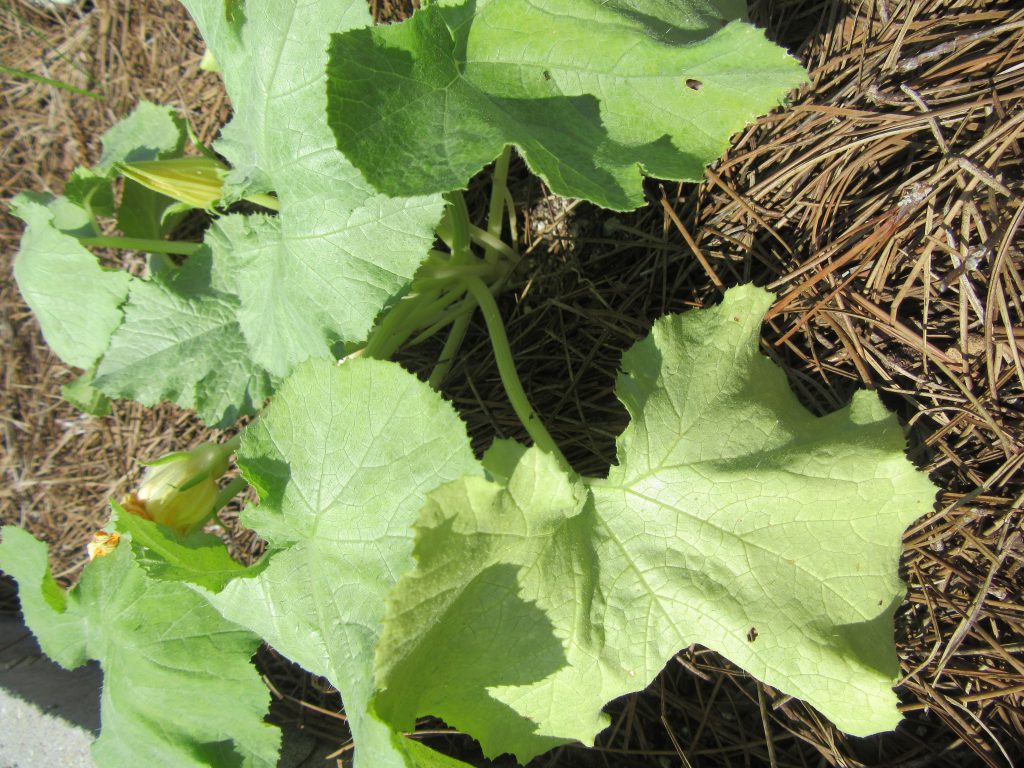
Pale squash leaves due to feeding from whiteflies. Photo Credit: University of Florida/IFAS.
So what should be done to control whiteflies? It depends on what is being grown. If whiteflies are present, the role of beneficial insects should be taken into consideration. Plenty of predatory insects such as lady bugs and green lacewings are around to feed on whiteflies. In fact, leaving the whiteflies alone on your trees and shrubs will attract more predatory insects. Below are some whitefly control methods that produce minimal damage to beneficial insect populations.
Whitefly Control in Vegetables
- Sticky Traps – Yellow sticky traps are a good way to monitor whitefly populations and can help determine when insecticide application is appropriate.
- Insecticidal Soaps – Insecticidal soaps are usually applied as a 1 to 2 percent solution (2½ to 5 tablespoons per gallon of water). It is important to follow the application directions on the label. Insecticidal soap should be applied in the evening, when the sun is low in the sky and the temperature is below 85°F. Some insecticidal soaps available at local lawn and garden centers include: Bonide Insecticidal Soap, Bonide Insecticidal Soap, and Bayer Advanced Natria Insecticidal Soap.
- Horticultural Oils – Horticultural oils should be handled like insecticidal soaps. Like the soaps, they should be applied in the evening. Some horticultural oils available at local lawn and garden centers include: Bonide All Seasons Spray Oil, Southern Ag Parafine Oil, and Garden Safe Neem Oil.
- Other Insecticides – Harsher chemicals are not recommended for the home gardener, because whiteflies have become resistant to most products on the market. Use of broad spectrum insecticides may also contribute to an increase in whitefly populations because they kill beneficial predatory insects.
Hopefully winter will be cooler this year and the profuse whitefly population will be knocked back. Until then, we wish all home gardeners the best of luck with fall gardening!
by Julie McConnell | Sep 18, 2017
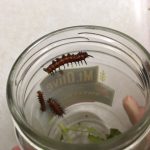
A glass jar with the lid secured is one method of bringing a live insect sample to your local Extension Office. Photo: JMcConnell, UF/IFAS
One of the roles of a Horticulture Extension Agent is to help identify pests found in the landscape. Weeds are fairly easy for people to sample, simply take some pictures or dig it up and bring it into the office, but what about insects?
Slow moving insects may be easy to photograph and if their size, shape, and coloration is very distinctive that may be enough for a good identification. But sometimes a photo isn’t worth a thousand words and the best way to get accurate identification is to bring in a physical sample.
The quality of the sample is going to either help or hinder with identification, so here are some tips:
- Never leave samples in a hot car – insects desiccate and become brittle in intense heat. Some details such as number of antennae segments or tarsi on legs are used to positively identify insects; missing pieces can lead to misidentification.
- Bring a live sample if it can be done safely and securely. Small, disposable plastic containers, jars with tightly sealing lids, and reused food or medicine containers work well.
- Small insects such as ants can be collected using a paintbrush dipped in rubbing alcohol which can then be swirled to release the ants into a vial/jar containing a small amount of alcohol. Small soft bodied insects can be collected this way, but may lose their color which may impede identification.
- Crushed or otherwise damaged samples should not be submitted.
- Limit samples to landscape or household pests – your local Extension Office is not a medical facility and is not equipped to handle or process samples that contain bodily fluids, skin scrapings, or similar materials. Please consult a physician for suspected human parasites.
Other helpful information that can be used for identification is the location of the insect, behavior (active night/day), and food source if known.
If insects must be mailed, please follow packaging directions found in this publication Insect Identification Service.
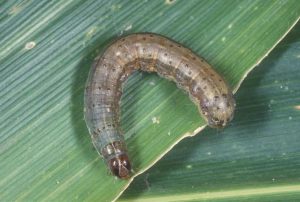
by Sheila Dunning | Aug 17, 2017
If you are one of the many that have taken advantage of the frequent rain in order to establish a new lawn, keep an eye open for “grass worms”. Though truly caterpillars, not worms, these destructive, chewing insects can wreak havoc on new sod.

Sod Webworm Photo by: Lyle Buss UF
Tropical sod webworm larvae are destructive pests of warm season turfgrasses in the southeastern U.S. especially on newly established sod. Larval feeding damage reduces turfgrass aesthetics, vigor, photosynthesis and density, which is very evident on finer-bladed grasses such as bermudagrass and zoysiagrass. Adults, a dull brown colored moth about ¾ inch long, rest in sheltered and shrubby areas during the day and are active at dusk. Females deposit clusters of 10-35 eggs on the upper surface of grass blades. The eggs hatch in 3-4 days and develop from a 1 mm long caterpillar to one over 11 mm long through six instars within 21 to 47 days, depending on temperature. Larval feeding occurs at night, leaving the grass looking ragged, shortened and missing.
Control should be against damaging larvae, not the flying moths. However, insecticidal soap applications to moth harboring areas can reduce re-population frequency if such areas are located. Soil-drenching soap flushes can be used to find the caterpillars, especially in dry and hot grass areas. Bacterial-based insecticides will control sod webworm caterpillars without impacting beneficial species as long as they are applied with each flush of grass growth.
Excessive fertilizing will lead to caterpillar outbreaks in lawns. Newly installed sod is usually rich in nutrients and rapid growing, which makes it very attractive to sod webworms. Grass installation over the summer months should be immediately followed by sod webworm treatment.

Fall Armyworm Photo by: Lyle Buss UF
Fall armyworms are also attracted to newly installed sod. They feed any time of the day or night, but are most active early in the morning or late in the evening. The 1 ½ inch long gray and white moth lays about 1,000 eggs in multiple masses on any vegetation. Two to 10 days later, the small caterpillar hatches and begins to grow to nearly 2 inches long over a two week period. The fall armyworm is easily recognized by its dark head marked with a distinct pale-colored inverted Y and the long black stripe running along each side of its body. These aggressive feeders “march” rapidly across grassed areas consuming every above-ground plant part. While bacterial-based insecticides will reduce the numbers, control of armyworms usually requires synthetic insecticides. Diligent inspection and early pesticide application is critical to establishment of new sod installed during the summer months.
by Larry Williams | Jul 21, 2017

Figure 1. Adult female Asian cockroach, Blattella asahinai Mizukubo, carrying an egg case (ootheca). Photograph by R.W. Baldwin, University of Florida.
The Asian cockroach was first identified as a newly introduced species in the U.S. in Lakeland, Florida in 1986. I started seeing this small cockroach in our area about 17 or 18 years ago. They’ve done well recently with the rains and their numbers are probably higher now as a result. They prefer warm, wet conditions. Populations of 30,000 to 250,000 per acre are reported in some literature.
They are mostly active at night, hiding in mulched landscape beds and lawns during the day. It’s not uncommon to disturb them as you walk through or hand water mulched plant beds during daytime hours. When doing so, the little roaches, which may be mistaken for small moths, quickly fly as they are disturbed.
Asian cockroaches occasionally fly into homes or automobiles at night, attracted to lights. Thankfully, they don’t live long indoors, though.
Control is difficult. Because they can fly 120 feet or more in a single flight, large areas around a home require treatment. And cockroaches in surrounding untreated areas (lawns, mulched plant beds and nearby woods) may result in re-infestation.
Traditional indoor treatments are ineffective because Asian roaches don’t typically live and breed indoors. The best control has been attained by using insecticide baits (labeled for roach control) in infested areas outdoors. Always follow the label directions and precautions when using any pesticide, including insecticides.
Sodium vapor lamps for outdoor lighting and yellow incandescent bulbs for porch lighting are less attractive to the flying adults.
Both the German and Asian cockroach adults are about 5/8 inch long and are brown to dark brown in color with two darker parallel bands running lengthwise just behind their head. But unlike the German cockroach, the Asian cockroach is a strong flier. Even though German cockroaches have wings, they do not fly. Also, unlike the German cockroach, which prefers to live indoors and is a major household pest as a result, the Asian cockroach prefers to live outside.
For more info on this roach species, visit the below UF/IFAS Extension EDIS website.
http://edis.ifas.ufl.edu/in277
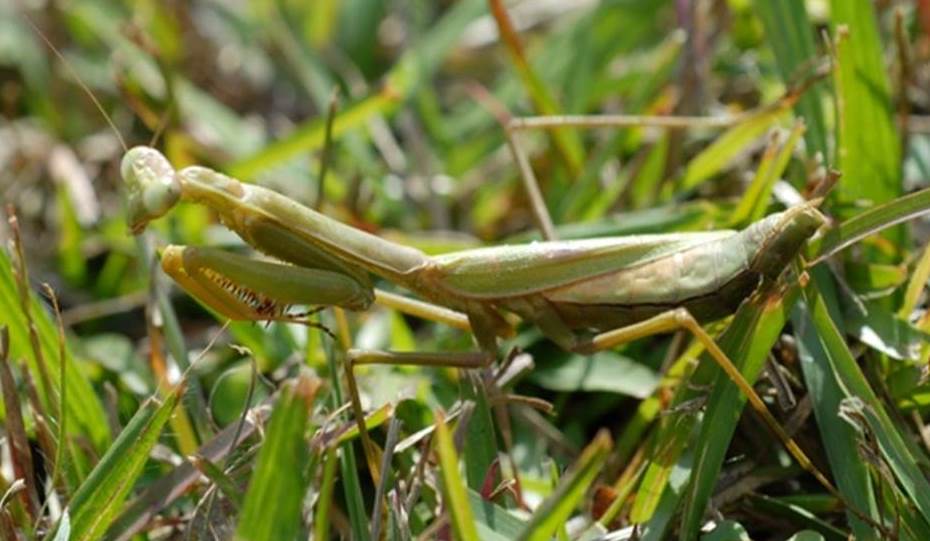
by Les Harrison | Jul 14, 2017

Praying Mantis, Image Credit Les Harrison
Summertime is bug time in the Florid Panhandle. The weather has provided enough rain for the bugs which depend on a supply of foliage and the temperatures have been ideal for a population explosion.
Stink bugs, leaf-footed bugs, grasshoppers, all sizes and colors of caterpillars and many more have been enjoying the lush and plentiful dining options. More than one Panhandle homeowner or gardener has been plagued by the sudden appearance of a hoard of hungry nuisances which are eyeing the menu choices at residences.
Fortunately, nature has a way of eventually balancing all situations when left to its own devices. With the increase of the plant eaters comes a surge in those insects which restrain the excess population.
One of the most easily recognized predator insects is the praying mantis. This beneficial insect is actually a family with multiple members, some of which have been introduced to Florida.
While there are over 2400 mantis members worldwide, Florida is home to eleven. Two of those exotics have been introduced from other regions, but considered non- invasive.
Mantises are thought to have evolved during the Cretaceous period about 100 million years ago, possibly from a predatory cockroach with similar front legs. Their closest surviving insect relatives are cockroaches and termites, both of which they will consume if given the opportunity.
Like many insects, the mantis is equipped with a tough, durable exoskeleton which provides a basis for successful close quarter combat and meal procurement. These hunters have three other advantages which create a severe vulnerability in their prey’s defense and potential for surviving a mantis encounter.
The mantis is an ambush predator which will lay in wait for the victim/meal to deliver itself. The mantis has the instinctive ability to identify and hide in areas with high amounts of prey species traffic.
This insect is a master at stealth and camouflage. The creature’s coloration and linear shape allow it to blend into the earth tones of many settings.
To complement its ability to conceal itself in plain sight, the mantis can hold perfectly still and patiently wait for the oblivious bug to bumble into sticking range. At that precise moment, the mantis is a blur of lethal motion.
The mantis’ forelimbs are a set of deadly spiked vices used to immobilize and secure its target. It extends these spiny levers forward in a raised position which appears as though it is in a mealtime prayer, hence its name.
The kill technique is to impale and restrain the victim with a single stroke of the forelimbs while holding the victim securely to the mantis’ body. On occasion the attempt fails and the mantis has to apply a more direct approach.
This insect’s beak is designed for slicing and tearing its victim’s body. Its jaw muscles provide the power to effectively employ this tool.
Depending on its stage of live, the mantis will eat a wide variety of creatures. Early stage mantises will eat little flies and other tiny insect (including its siblings), but at maturity they will take on small reptiles and amphibians along with a variety of destructive insects.
Female mantises will even consume their prospective mates. Despite its vicious and cannibalistic nature, the praying mantis is the answer to many gardeners’ prayers.
To learn more about praying mantises and other beneficial insects, check out this EDIS site with many articles on various species of beneficial insects.










